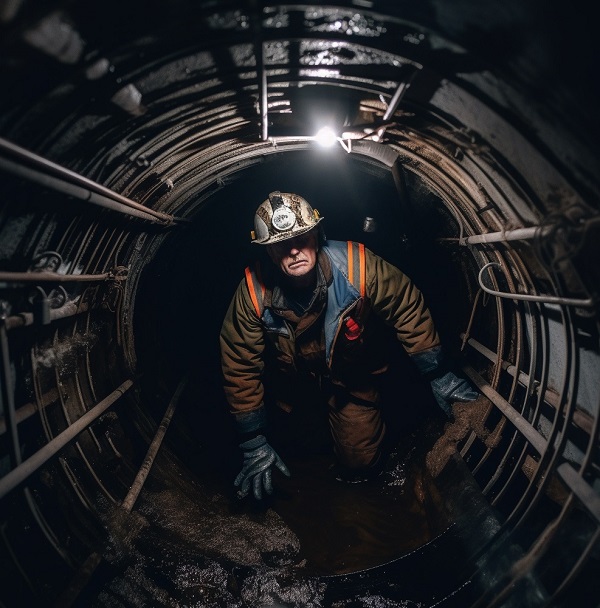Let me tell you a story about a tragic incident that happened in a sewer line manhole. It’s a somber tale, but one that’s important to learn from. Picture this: a construction foreman, a hardworking fella, lost his life to asphyxiation after stepping into a manhole filled with a dangerous atmosphere.
On a quiet job site, four construction workers were busy in an inactive sewer system. Suddenly, they noticed their foreman was missing, and a manhole cover was wide open. One worker quickly dialed up emergency services, while another bravely climbed into the manhole to help the foreman. Sadly, the foreman was found unresponsive, deep down 20 feet below the surface. The second worker got disoriented, but luckily, he managed to scramble out after another worker blew fresh air into the manhole with a fan. Despite the fire department’s best efforts, the foreman was declared dead due to asphyxiation.
Now, let’s break down what likely caused this heartbreaking incident. That manhole, even though it was brand spanking new and not yet connected to an active sewer system, contained a hazardous atmosphere that led to the foreman’s asphyxiation. The employer didn’t do their part in making sure the atmosphere was checked and safety measures were in place before work began.
Here’s what went wrong:
- The workers didn’t get the training they needed to recognize confined space hazards and take the necessary precautions.
- Nobody assessed the manhole’s atmosphere to ensure it was safe before or during entry.
- Proper ventilation wasn’t used to control the hazards in the manhole.
- Protective and emergency equipment wasn’t provided at the worksite.
- There wasn’t an attendant stationed outside the manhole to keep an eye on things and call for help if needed.
To paint a clearer picture, this incident involved a confined space asphyxiation on a sunny day, with temperatures between 61-67°F. The four-person crew was installing a sanitary sewer system. It’s unknown if a worksite inspection was conducted, but there was no competent safety monitoring, safety and health program, or worker training in place. The foreman, a 46-year-old man, had 15 years on the job but had been at this task for less than an hour. He spoke English, worked full time, and was a union member.
The foreman’s asphyxiation occurred because he didn’t get enough oxygen to sustain life. This was due to low oxygen levels and/or high carbon dioxide levels in the atmosphere. Though we don’t know the exact conditions inside the manhole at the time, measurements taken afterward suggest that oxygen levels may have been low enough, and/or carbon dioxide levels high enough, to cause asphyxiation.
Take this story as a lesson, folks – always prioritize safety and make sure you and your team are well-trained and prepared for any hazards that might come your way.
Now that we’ve gone through the details of this sad story, it’s important to shift our focus on how to prevent such incidents from happening in the future. The key lies in understanding confined spaces, permit-required confined spaces (PRCS), and implementing a PRCS program to ensure safe entry operations. Let’s dive into what employers need to do to keep their workers safe and avoid tragedies like the one we just discussed.
Incident Prevention Employers must identify confined spaces and permit-required confined spaces (PRCS) where workers may be assigned duties before starting work at a construction site.
A PRCS has one or more of the following characteristics:
- Contains or has the potential to contain a hazardous atmosphere.
- Contains a material with potential for engulfment.
- Has an internal layout that could trap or asphyxiate an entrant.
- Contains any other serious physical or health hazard.
Employers with workers entering one or more PRCS must implement a PRCS program for safe permit space entry operations, including:
- Providing no-cost, understandable training to workers on safely performing permit space duties before their first assignment and as needed.
- Prohibiting entry into permit spaces until hazardous conditions are identified, evaluated, and addressed.
- Eliminating or controlling atmospheric hazards through ventilation, purging, inerting, or flushing the permit space as necessary.
- Performing pre-entry testing for oxygen content, flammable gases and vapors, and potential toxic air contaminants. 5. Continuously monitoring the permit space to verify that atmospheric conditions remain acceptable during entry.
- Providing essential equipment to workers with training on proper use, including: a. Personal protective equipment when necessary. b. Rescue and emergency equipment for authorized workers, or implementing procedures for rescue and emergency services. c. Stationing at least one trained attendant outside a permit space to perform all attendant’s duties.
Remember, it’s crucial to follow OSHA guidelines and regulations to ensure the safety and well-being of your workers. By doing so, you can help prevent tragic incidents like this from happening in the future.
References:


